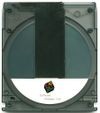1967: Magneto-Optical storage demonstrated
Magneto-Optical capacity outstripped magnetic disks in the 1980s




Work on magneto -optical (MO) technologies for data storage began in the 1950s and ‘60s at Bell Telephone, Honeywell, IBM, 3M, and at other labs in the U.S., Europe and Japan. Writing and erasure of information on magneto-optical films employs a thermomagnetic process. At ambient temperature the material has a high coercivity (a measure of the ease of magnetization) and does not respond to an applied magnetic field. When heated to the Curie-Point by a focused laser beam, the film decreases in coercivity allowing an electromagnet to reverse the direction of magnetization. Once cooled the domain is fixed and is read using the Kerr effect that senses the direction of magnetization from the rotation of a polarized beam of reflected light. Data can be erased and rewritten an unlimited number of times.
Di Chen demonstrated data storage on thin films of MnBi at Honeywell, Minneapolis, MN in 1967. Semiconductor radiation emitting diodes brought commercial drives with media based on amorphous magnetic films mounted in in removable cartridges to market in the 1980s. Steve Jobs’ fabled 1988 presentation of a 256 MB, 5.25-inch MO drive in the NeXT workstation introduced the technology to a world-wide audience. Although it was extremely reliable and offered high capacity, slow-writing made MO unsuitable for applications other than secure and archival storage. The latter were often incorporated into robotic libraries.
Many vendors of drives and media emerged, including giants HP, IBM, Kodak, Philips, Pioneer, and 3M, as well as start-ups Laser Byte, MaxOptix, MOST, and Pinnacle Micro. 5.25-inch disks offered capacities from 256 MB to 9.2 GB and 3.5-inch and Sony MiniDisc formats proved popular for Nintendo and other entertainment systems. Lower cost CD/DVD drives and flash memory sticks have largely replaced MO devices.
Contemporary Documents
- Mayer, L. "Curie-point writing on magnetic films" J. Appl. Physics (Vol.29 1958) p.1003
- Chang James T H, e. al. “Magnetic-optical information storage unit and apparatus” U.S. Patent # 3164816 (Filed Dec 18, 1963 Issued: Jan 5, 1965)
- Pershan, P. S. "Magneto-Optical Effects" Journal of Applied Physics (Vol:38 No: 3 January 1967) p. 1482
- Chen, D. “Thin films of MnBi for beam addressable beam alterable optical memory applications” Electron Devices Meeting, 1967 International (Vol: 13) p.96
- Aagard, R., Chen, D., Honebrink, R., Otto, G. “Optical mass memory experiments on thin films of MnBi” Magnetics" IEEE Transactions on (Vol:4, Issue: 3 Sep 1968) pp. 412 - 416
- Freiser, M. "A survey of magnetooptic effects" IEEE Transactions on Magnetics (Vol: 4 No: 2 June 1968) pp. 152–161
- Goldberg; Norman, Roger Newman “Magneto-Optic Information Storage Apparatus” U.S. Patent # 3,651,504 (Filed October 17, 1969 Issued: March 21, 1972)
- Chen, Di. "Magneto-Optic Principles, Materials and Applications" Proc. SPIE 0038, Electro-Optics Principles and Applications, 9 (June 1, 1973)
More Information
- Optical Storage Revolution Exhibit Computer History Museum
- Mansuripur. Masud. The Physical Principles of Magneto-Optical Recording, Cambridge University Press (1995)
- Gambino, R. and T. Suzuki. (Eds) Magneto-Optical Recording Materials IEEE Press 1999 Ch 1, Ch 2, & Ch11 (All optical disc media)
- Leonard, Peter. “NeXT Optical Discs” (Retrieved on 1.13.15 from: http://www.thegogglesdonothing.com/archives/2010/03/next_optical_discs.shtml)
- Wang, Shan X. Magnetic Information Storage Technology, Academic Press (1999) pp. 503 – 516
- Wang, Shan X., Alexander M. Tarartorin, “Optical Disk Recording” Magnetic Information Storage Technology, Academic Press (1990) pp. 495 - 513
- “The Invention of the Rewritable Magneto-Optical Disk” (Retrieved on 1.13.15 from: http://www-03.ibm.com/ibm/history/ibm100/us/en/icons/rewritablecd/)
- “Milestones: IBM Thomas J. Watson Research Center, 1960 – 1984” Engineering and Technology History Wiki (for magneto-optical storage) (Retrieved on 12.2.15 from: http://ethw.org/Milestones:IBM_Thomas_J._Watson_Research_Center,_1960_-_1984)
Oral Histories
- “Harker, Jack (John M.) oral history, with C. Denis Mee” Computer History Museum Oral History # 102658172 (2006-05-30)
- “Interview with Dr. Gary Boyd” Center for History of Physics of the American Institute of Physics (December 2, 2008)
1967_MO_v2
Rev 8.24.15


